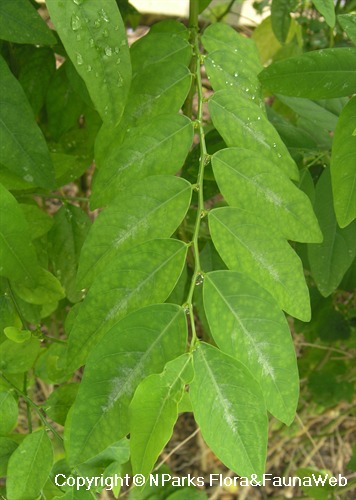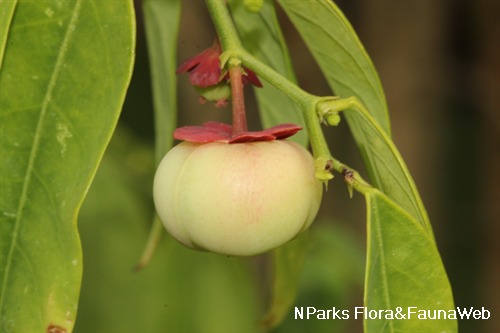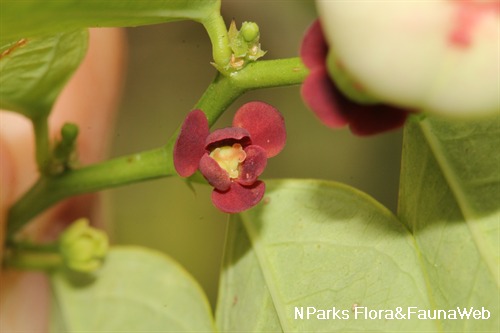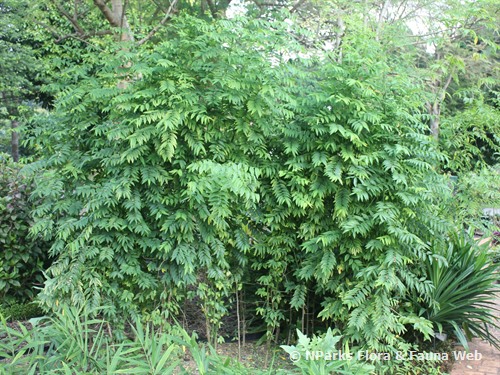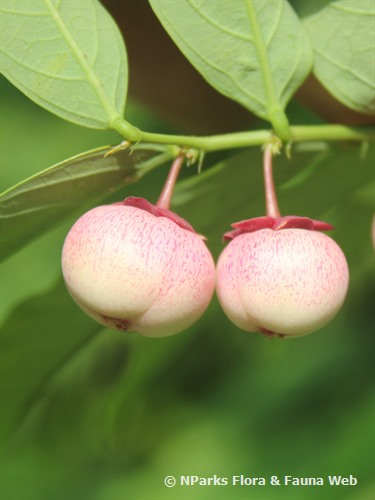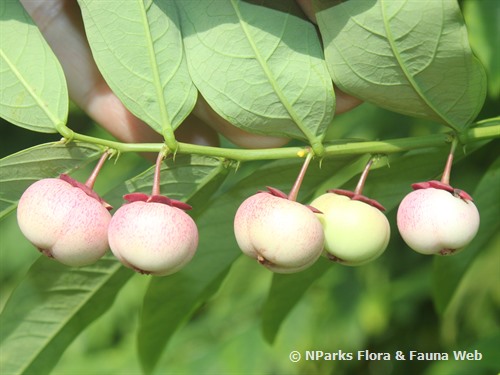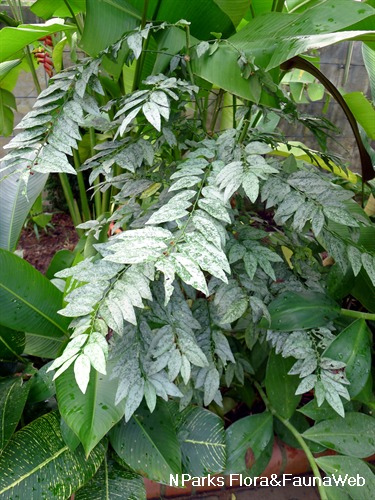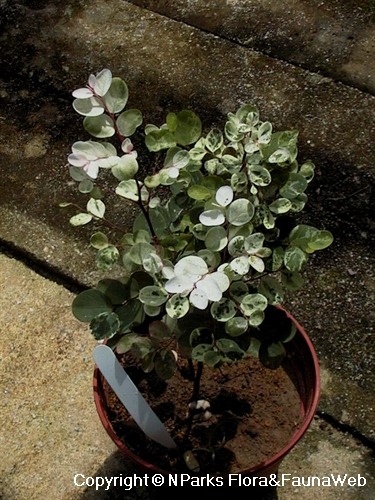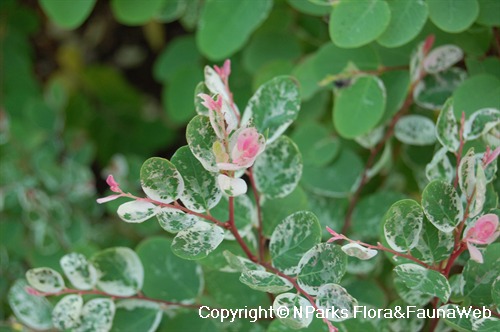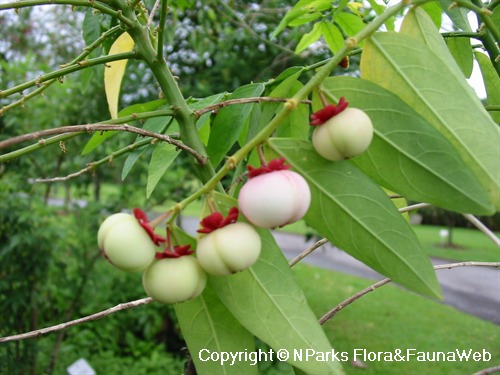
Back
Breynia androgyna (L.) Chakrab. & N.P.Balakr.
| Family Name: | Phyllanthaceae |
| Synonyms: | Sauropus androgynus, Sauropus albicans |
| Common Name: | Cekur Manis, Chekur Manis, Cekuk Manis, Sayur Manis, Pucuk Manis, Star Gooseberry, Sweet Leaf Bush, Katuk, 马尼菜, 守宫木 |
Cekur Manis is a shrub often eaten as a vegetable which can be found in Singapore's local markets. Its young shoots and leaves can be stir-fried or boiled in soup. It is also grown for its ornamental silvery leaf and fruit that resemble tiny mangosteen fruit.
Name
Classifications and Characteristics
| Plant Division | Angiosperms (Flowering Seed Plants) (Dicotyledon) |
|---|---|
| Plant Growth Form | Shrub |
| Lifespan (in Singapore) | Perennial |
| Mode of Nutrition | Autotrophic |
| Plant Shape | Shrubby |
| Maximum Height | 2 m to 5 m |
Biogeography
| Native Distribution | Tropical and Subtropical Asia |
|---|---|
| Native Habitat | Terrestrial (Monsoon Forest, Secondary Rainforest, Freshwater Swamp Forest, Riverine, Disturbed Area / Open Ground) |
| Preferred Climate Zone | Tropical, Sub-Tropical / Monsoonal |
| Local Conservation Status | Native to Singapore (Vulnerable (VU)) |
Description and Ethnobotany
| Growth Form | Shrub, up to 5 m tall as a wild understorey forest plant, but normally kept to around 2 m under cultivation. |
|---|---|
| Foliage | Ovate to elliptic leaves (1.8-9.5 cm long, 0.6-4 cm wide) have short, 2-3 mm long petioles. |
| Stems | Stems vertical, somewhat woody. |
| Flowers | Male and female flowers lack petals and occur on the same plant in the leaf axils. Female flowers have 6 red sepals surrounding a single cream-coloured pistil, while male flowers have 6 cream-coloured sepals enclosing 3 reddish stamens. |
| Fruit | Small, white fruit shaped like a mangosteen (12-17 mm long, 9-15 mm wide) turns maroon at maturity and releases white or black seeds by explosive dehiscence. |
| Habitat | It can be found in forests, near rivers, and open habitats up to 1,500 m above sea level. It can be found in Pulau Ubin. |
| Cultivation | Cekur Manis grows well in semi-shade or full sun, but it will produce more leaves under semi-shade. Regular pruning, frequent harvesting of the leaves and regular feeding with a nitrogen rich fertiliser will stimulate the plant to produce more leaves. It grows best in acidic (pH 6-7), well-drained soil that is kept moist, but it will also tolerate heavy clay soil. In general, it is easy to grow with few pest and disease problems, but can occasionally be attacked by beetles. It is often propagated by stem cuttings which root easily. |
| Etymology | The genus Breynia is named after 17th century Polish botanists Jacob Breyne and his son Johann Philipp Breyne. The specific epithet androgyna is a Latin word referring to the presence of male and female flowers on the same plant. |
| Ethnobotanical Uses | Edible Plant Parts : Edible Leaves, Edible Fruits, Edible Flowers, Edible Stems Food (Fruit or Vegetable): In South and Southeast Asia, the leaves, stems, flowers and immature fruit are eaten as a vegetable after cooking, such as by stir-frying, boiling or steaming. Its taste has been compared to spinach, garden peas and asparagus. The plant is rich in nutrients, such as beta-carotene and vitamins C and E. However, the plant should only be eaten after thorough cooking and as part of a varied and well-balanced diet. (Warning: Consumption of its raw plant parts, such as adding them to salads and smoothies, could lead to serious and permanent lung damage or even death. Plant parts are safe for consumption after thorough cooking.) Medicinal: In South Asia, Southeast Asia and China, the plant is used in traditional medicine to treat a wide range of ailments including cough, fever, hypertension, diabetes, vision loss and diseases of the gastrointestinal and urinary systems. It is also used to promote lactation, weight loss and wound healing (Zhang et al., 2020). Some of these medical uses are supported by laboratory studies which have linked the plant's rich and diverse range of bioactive compounds to medicinally useful properties, such as anti-microbial and anti-inflammatory activity (Bunawan et al., 2015). However, it is important to note that there are compounds present in the raw plant that have led to damage to lung tissues and even death in people. More research is required to understand how the plant's medicinally useful compounds can be extracted and separated from other potentially harmful compounds in the plant. |
Landscaping Features
| Desirable Plant Features | Ornamental Fruits |
|---|---|
| Landscape Uses | Hedge / Screening |
| Thematic Landscaping | Economic Garden |
| Usage Hazard - Cons | Toxic Upon Ingestion |
| Usage Hazard - Cons Remarks | The plant must be thoroughly cooked before it is safe for consumption. |
Fauna, Pollination and Dispersal
| Seed or Spore Dispersal | Abiotic (Explosive Dehiscence) |
|---|
Plant Care and Propagation
| Light Preference | Full Sun, Semi-Shade |
|---|---|
| Water Preference | Moderate Water, Lots of Water |
| Plant Growth Rate | Fast |
| Rootzone Tolerance | Fertile Loamy Soils, Well-Drained Soils, Heavy Clay Soils, Acidic (low pH) Soils, Easy to Grow |
| Transplanting Tolerance | Good |
| Maintenance Requirements | Low |
| Propagation Method | Seed, Stem Cutting |
| Propagule Establishment Remarks | Stem cuttings root easily. |
Foliar
| Foliage Retention | Evergreen |
|---|---|
| Mature Foliage Colour(s) | Green, Silver / Grey |
| Mature Foliage Texture(s) | Papery |
| Foliar Type | Simple / Unifoliate |
| Foliar Arrangement Along Stem | Alternate |
| Foliar Attachment to Stem | Petiolate |
| Foliar Shape(s) | Non-Palm Foliage (Ovate, Elliptical) |
| Foliar Venation | Pinnate / Net |
| Foliar Margin | Entire |
| Foliar Apex - Tip | Acute |
| Foliar Base | Rounded / Obtuse, Truncate / Square |
| Typical Foliar Area | Nanophyll ( 0.25cm2 - 2.25 cm2 ), Microphyll ( 2.25cm2 - 20.25 cm2 ), Notophyll ( 20.25cm2 - 45 cm2 ) |
| Leaf Area Index (LAI) for Green Plot Ratio | 4.5 (Shrub & Groundcover - Dicot) |
| Typical Foliar Size | 1.8 cm to 9.5 cm |
Non - Foliar and Storage
| Root Type | Underground (Fibrous Root) |
|---|
Floral (Angiosperm)
| Flower & Plant Sexuality | Unisexual Flowers , Monoecious |
| Flower Colour(s) | Red, Cream / Off-White |
|---|
| Flower Grouping | Cluster / Inflorescence |
| Flower Location | Axillary |
| Flower Symmetry | Radial |
| Flowering Habit | Polycarpic |
Fruit, Seed and Spore
| Mature Fruit Colour(s) | Red, Brown |
|---|---|
| Fruit Classification | Simple Fruit |
| Fruit Type | Dehiscent Dry Fruit , Capsule |
References
| References | Bunawan, H. et al. (2015). Sauropus androgynus (L.) Merr. induced bronchiolitis obliterans: from botanical studies to toxicology. Evidence-Based Complementary and Alternative Medicine 2015: Article 714158, 7 pages. Khoo, H.E. et al. (2015). Sauropus androgynus leaves for health benefits: hype and the science. The Natural Products Journal 5: 115-123. Zhang, B.D. et al. (2020). Sauropus androgynus (L.) Merr.- A phytochemical, pharmacological and toxicological review. Journal of Ethnopharmacology 257: Article 112778, 13 pages. |
|---|
Image Repository
Others
| Master ID | 1134 |
|---|---|
| Species ID | 2427 |
| Flora Disclaimer | The information in this website has been compiled from reliable sources, such as reference works on medicinal plants. It is not a substitute for medical advice or treatment and NParks does not purport to provide any medical advice. Readers should always consult his/her physician before using or consuming a plant for medicinal purposes. |

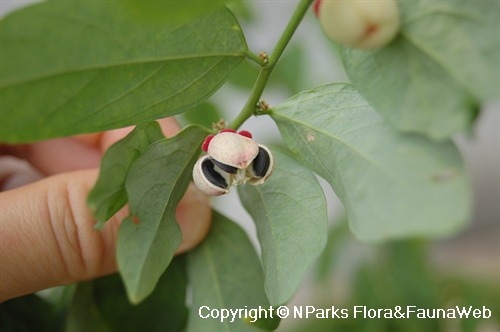
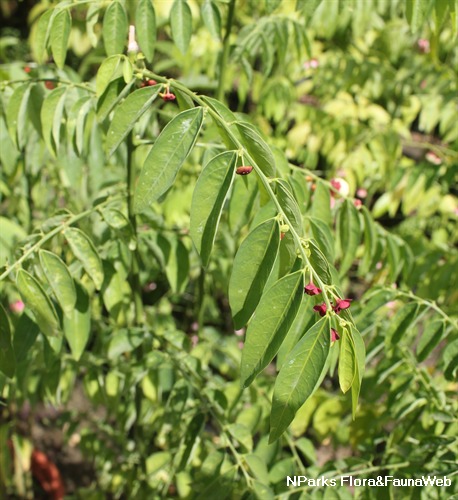
.jpg)
